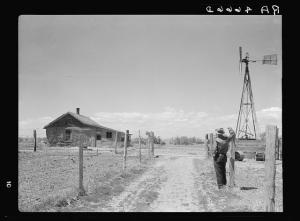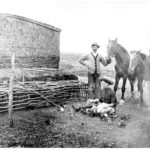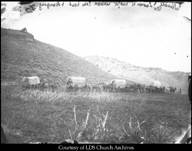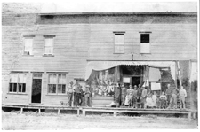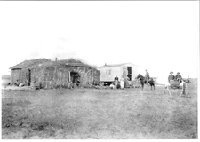Much of the commentary concerning insane asylums tends toward the negative, and rightly so, since they were often places of confinement for people who were in them unwillingly. Treatments were also much too vigorous at times, and many patients must have felt a pervasive sense of potential violence within the institution. Continue reading
Tag Archives: sod homes
The Other Half
In contrast to the Gilded Age mansions of the Vanderbilts and Rockefellers (see last post), most American families lived in considerably humbler abodes during the late nineteenth century. Families striving to create a new life in western lands often lived primitively, creating a first home out of whatever materials came to hand. Because trees were scarce, sod homes were common in the prairie states. It was far more important to build by a stream or within the shelter of a hill than to strive for a certain architectural style or type of building material.
Sod homes were difficult to build, but they were cheap and a definite step up from the dugouts that many families stayed in when they first settled. Dugouts were merely holes in the side of a hill which families quickly excavated in order to get out of their tents and covered wagons. Many times, they built their sod home in front of the original dugout and kept using the dugout as a room. Sod homes could be cozy and warm, and because they were built of dirt, fireproof. However, snakes, mice, and insects could find their way in, and often did. Dirt was a constant problem, and earth sometimes dropped in chunks from the ceiling or trickled down in a muddy drizzle during rainy weather. The roof itself might collapse during heavy rains, while underfoot, the floor turned to mud. Women could be constantly exasperated by the drawbacks of sod homes, and many wished for the relative comforts they had left behind in the East.
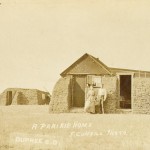
Prairie Home in Dupree, SD, courtesy Special Collections and University Archives, Wichita State University
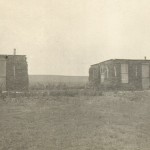
Early Homes for Settlers in SD, courtesy Special Collections and University Archives, Wichita State University
______________________________________________________________________________________
Settling the Old West
Many popular myths and conceptions surround the settling of America’s Old West. The truth is that it was a long, difficult process–both to distribute land and to settle it. The federal government began to distribute land almost since the country was founded, but it wasn’t especially easy. At first, land was measured against landmarks. Boundaries could be a little fuzzy with this method, and the government eventually began to measure against astronomical points.
The government didn’t want to just give away land–they wanted to add to the new country’s treasury. Prior to 1800, the government sold 640-acre parcels of land for $1 an acre. Buyers had to purchase the whole plot, and $640 was a lot of money. After 1800, the purchase requirement was dropped to 320 acres–which was a little bit easier for settlers to clear and plant–and purchasers were allowed to pay in installments. The new price was $1.25 an acre, and was still steep for most would-be farmers.
After 1852, the government priced land based more on its perceived value. Land that had been available and unsold for 30 years, for instance, was re-priced at 12.5 cents an acre. To 21st-century landowners, that price seems unbelievably cheap. However, clearing land without powerful machines was difficult and backbreaking, and it was hard for families to leave their communities and social networks to strike out on their own.
The government had to get creative to really get settlers willing to push westward, and my next posts will show the settlement process.
________________________________________________________________________
